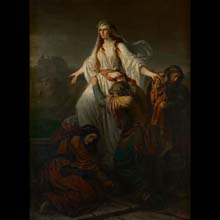
material: oil on canvas
dimensions: 272 × 200 cm
description: The painting illustrates one of the most popular legends referring to the prehistory of Poland. It depicts Wanda, the daughter and successor of the mythical king Krak a moment before jumping into the Vistula river. The queen, portrayed against the Wawel castle, surrounded by desperate ladies-in-waiting, is giving them her royal robes and jewellery. The reverse bears the following inscription: “According to the vow she had taken, having defeated her attacker Rytogar, Queen Wanda makes an offering of herself to gods by throwing herself into the Vistula river". It shows that the author of this work chose the version of the legend told by Jan Długosz in "Kroniki sławnego Królestwa Polskiego" [The Chronicles of the Famous Kingdom of Poland]. The myth of Wanda, which was cultivated in Midsummer Night’s Eve tradition of throwing garlands of flowers into the Vistula, acquired special significance at the time of the Partitions of Poland. The prehistoric queen was worshipped almost like a saint, while her sacrifice and the “eternal” presence in the Vistula gave the legend a founding and unifying character, uniting the nation divided by the partitioners. The work, reminiscent of German Romanticism in terms of style and dramatic in expression, monumentalizes and heroizes the figure of Wanda. Wacława Milewska
exposition: The Gallery of 19th Century Polish Art in Sukiennice,
The Cloth Hall, 1, Main Market Square
key: Around the academy >>>
dimensions: 272 × 200 cm
description: The painting illustrates one of the most popular legends referring to the prehistory of Poland. It depicts Wanda, the daughter and successor of the mythical king Krak a moment before jumping into the Vistula river. The queen, portrayed against the Wawel castle, surrounded by desperate ladies-in-waiting, is giving them her royal robes and jewellery. The reverse bears the following inscription: “According to the vow she had taken, having defeated her attacker Rytogar, Queen Wanda makes an offering of herself to gods by throwing herself into the Vistula river". It shows that the author of this work chose the version of the legend told by Jan Długosz in "Kroniki sławnego Królestwa Polskiego" [The Chronicles of the Famous Kingdom of Poland]. The myth of Wanda, which was cultivated in Midsummer Night’s Eve tradition of throwing garlands of flowers into the Vistula, acquired special significance at the time of the Partitions of Poland. The prehistoric queen was worshipped almost like a saint, while her sacrifice and the “eternal” presence in the Vistula gave the legend a founding and unifying character, uniting the nation divided by the partitioners. The work, reminiscent of German Romanticism in terms of style and dramatic in expression, monumentalizes and heroizes the figure of Wanda. Wacława Milewska
exposition: The Gallery of 19th Century Polish Art in Sukiennice,
The Cloth Hall, 1, Main Market Square
key: Around the academy >>>












